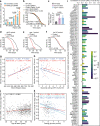Grainyhead 1 acts as a drug-inducible conserved transcriptional regulator linked to insulin signaling and lifespan
- PMID: 35013237
- PMCID: PMC8748497
- DOI: 10.1038/s41467-021-27732-4
Grainyhead 1 acts as a drug-inducible conserved transcriptional regulator linked to insulin signaling and lifespan
Abstract
Aging is impacted by interventions across species, often converging on metabolic pathways. Transcription factors regulate longevity yet approaches for their pharmacological modulation to exert geroprotection remain sparse. We show that increased expression of the transcription factor Grainyhead 1 (GRH-1) promotes lifespan and pathogen resistance in Caenorhabditis elegans. A compound screen identifies FDA-approved drugs able to activate human GRHL1 and promote nematodal GRH-1-dependent longevity. GRHL1 activity is regulated by post-translational lysine methylation and the phosphoinositide (PI) 3-kinase C2A. Consistently, nematodal longevity following impairment of the PI 3-kinase or insulin/IGF-1 receptor requires grh-1. In BXD mice, Grhl1 expression is positively correlated with lifespan and insulin sensitivity. In humans, GRHL1 expression positively correlates with insulin receptor signaling and also with lifespan. Fasting blood glucose levels, including in individuals with type 2 diabetes, are negatively correlated with GRHL1 expression. Thereby, GRH-1/GRHL1 is identified as a pharmacologically malleable transcription factor impacting insulin signaling and lifespan.
© 2022. The Author(s).
Conflict of interest statement
The authors declare no competing interests.
Figures





Similar articles
-
Regulation of the Caenorhabditis elegans longevity protein DAF-16 by insulin/IGF-1 and germline signaling.Nat Genet. 2001 Jun;28(2):139-45. doi: 10.1038/88850. Nat Genet. 2001. PMID: 11381260
-
Insulin/IGF-1-mediated longevity is marked by reduced protein metabolism.Mol Syst Biol. 2013 Jul 2;9:679. doi: 10.1038/msb.2013.35. Mol Syst Biol. 2013. PMID: 23820781 Free PMC article.
-
End-of-life targeted degradation of DAF-2 insulin/IGF-1 receptor promotes longevity free from growth-related pathologies.Elife. 2021 Sep 10;10:e71335. doi: 10.7554/eLife.71335. Elife. 2021. PMID: 34505574 Free PMC article.
-
Lessons from C. elegans: signaling pathways for longevity.Trends Endocrinol Metab. 2012 Dec;23(12):637-44. doi: 10.1016/j.tem.2012.07.007. Epub 2012 Aug 30. Trends Endocrinol Metab. 2012. PMID: 22939742 Free PMC article. Review.
-
5'-AMP-Activated Protein Kinase Signaling in Caenorhabditis elegans.Exp Suppl. 2016;107:375-388. doi: 10.1007/978-3-319-43589-3_15. Exp Suppl. 2016. PMID: 27812988 Review.
Cited by
-
Oleanolic Acid Slows Down Aging Through IGF-1 Affecting the PI3K/AKT/mTOR Signaling Pathway.Molecules. 2025 Feb 6;30(3):740. doi: 10.3390/molecules30030740. Molecules. 2025. PMID: 39942843 Free PMC article.
-
Recent Progress in Regulation of Aging by Insulin/IGF-1 Signaling in Caenorhabditis elegans.Mol Cells. 2022 Nov 30;45(11):763-770. doi: 10.14348/molcells.2022.0097. Epub 2022 Nov 15. Mol Cells. 2022. PMID: 36380728 Free PMC article. Review.
-
A naturally occurring polyacetylene isolated from carrots promotes health and delays signatures of aging.Nat Commun. 2023 Dec 8;14(1):8142. doi: 10.1038/s41467-023-43672-7. Nat Commun. 2023. PMID: 38065964 Free PMC article.
References
-
- McCay CM. Retarded growth lifespan, ultimate body size, and age changes in the albino rat after feeding diets restricted in calories. J. Nutr. 1937;18:1–13. - PubMed
-
- Klass MR. A method for the isolation of longevity mutants in the nematode Caenorhabditis elegans and initial results. Mech. Ageing Dev. 1983;22:279–286. - PubMed
-
- Finkel T. The metabolic regulation of aging. Nat. Med. 2015;21:1416–1423. - PubMed
Publication types
MeSH terms
Substances
Grants and funding
LinkOut - more resources
Full Text Sources
Medical
Molecular Biology Databases
Research Materials
Miscellaneous

